Children and Youth Demographics
Demographics
In 2019, there were an estimated 385,324 children and youth below the age of 24 living in Travis County comprising approximately 31% of the population, with an estimated 269,942 children below the age of 18, or 21% of the population. Children and youth were about evenly distributed among the age groups shown below. The share of children and youth under 24 living in the community has declined to approximately 31% since reaching a high of 37% in 2008.
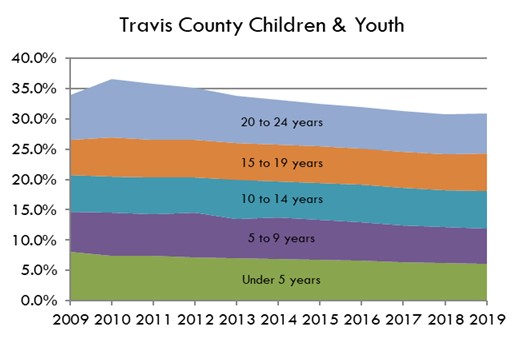
Definition: Population in a given age group as a percent of
Data Source: American Community Survey,1-year Estimates
Data Considerations: The American Community
Race and Ethnicity
The Under 18 population is more likely to identify as Hispanic or Latino than the overall population and less likely to identify as White Alone. In 2019, people identifying as Hispanic made up 46% of the under 18 population, compared to 34% of the overall population. Children were less likely to identify as White Alone– 36% of the under 18 population compared to 49% of the overall population.
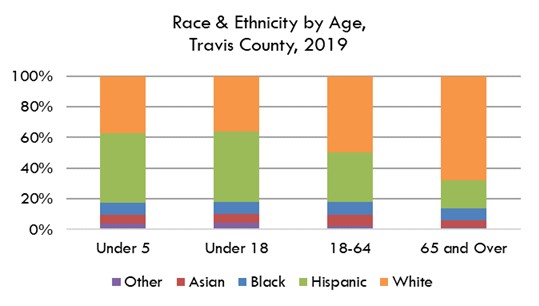
Definition: Race and Ethnicity of the Travis County Population
Data Source: American Community Survey, 1-year Estimates
Data Considerations: The American Community Survey samples 3% of the Nation’s population. Due to small sample sizes, margins of error are increased and hard to reach populations may not be accurately represented in the data.
Children in Poverty
The percent of children in poverty in Travis County decreased to 14% in 2019, from a maximum of 26% in 2012. Nevertheless, a significant share of local children live in families with incomes below the poverty thresholds. About 13%, of children in the 5-county Greater Austin area, and 16% of children in the City of Austin have incomes below the poverty level.
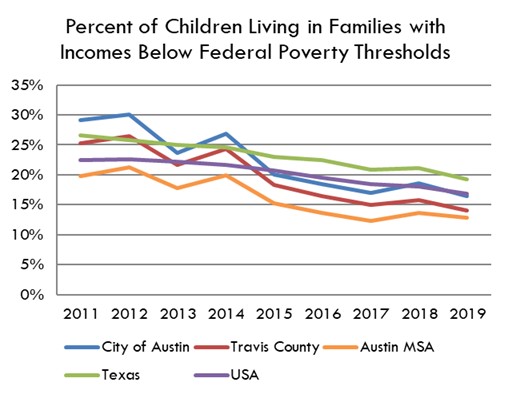
Definition: Percent of the under 18 population living in families with incomes below 100% of federal poverty thresholds. Federal Poverty Thresholds, as calculated by the U.S. Census Bureau can be accessed here.
Data Source: American Community Survey, 1-year Estimates
Data Considerations: The American Community Survey samples 3% of the Nation’s population. Due to small sample sizes, margins of error are increased and hard to reach populations may not be accurately represented in the data.
Children in Poverty by County
The percent of children in poverty varies across the Austin Metropolitan Area. Children in the Travis and Hays County area most likely to live in families with incomes below poverty thresholds, with approximately 1 in 7 children (14% in Travis , 13% in Hays), experiencing poverty. Children in Williamson County are least likely to experience poverty, with 6% of children living in families with poverty-level incomes.
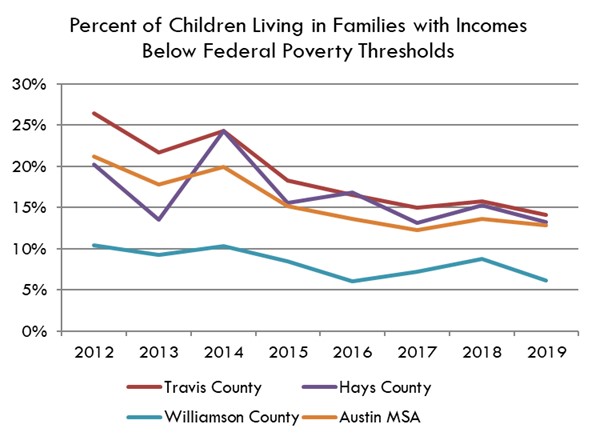
Definition: Percent of the under 18 population living in families with incomes below 100% of federal poverty thresholds, by county, for 4 counties in the Austin Metro Area. Federal Poverty Thresholds, as calculated by the U.S. Census Bureau can be accessed here.
Data Source: American Community Survey, 1-year Estimates
Data Considerations: The American Community Survey samples 3% of the Nation’s population. Due to small sample sizes, margins of error are increased and hard to reach populations may not be accurately represented in the data.
Where Children Live
A majority of children (71%) in Travis County live in married-couple family households. Seventeen percent of children live in families headed by a single female. Another 5% of children live in households headed by a single male. Seven percent of children live in cohabiting couple households. Since the percentages above are estimates that may include rounding, the total may add up to more than 100%.
Household type may correlate with other indicators on the Dashboard. Households headed by a single adults have higher rates of poverty than households headed by married couples. In 2019, 37% of female householder families with children under 18 had incomes below the Federal Poverty Level. That’s over twice (18%) what was reported for households with children under 18 headed by single males, and over nine times (4%) what was reported for households with children under 18 headed by married couples.
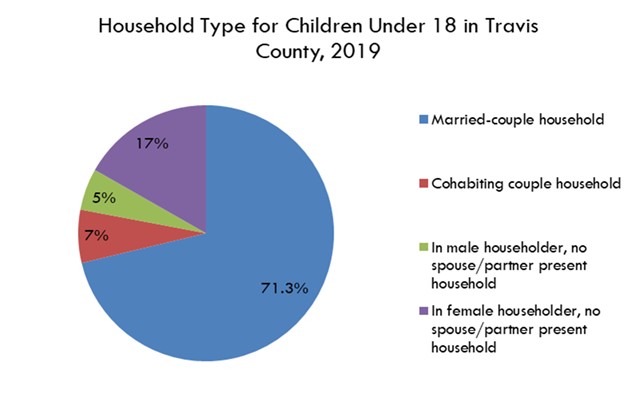
Definition: Race and Ethnicity of the Under 18 Population
Data Source: American Community Survey, 1-year Estimates
Data Considerations: The American Community Survey samples 3% of the Nation’s population. Due to small sample sizes, margins of error are increased and hard to reach populations may not be accurately represented in the data.
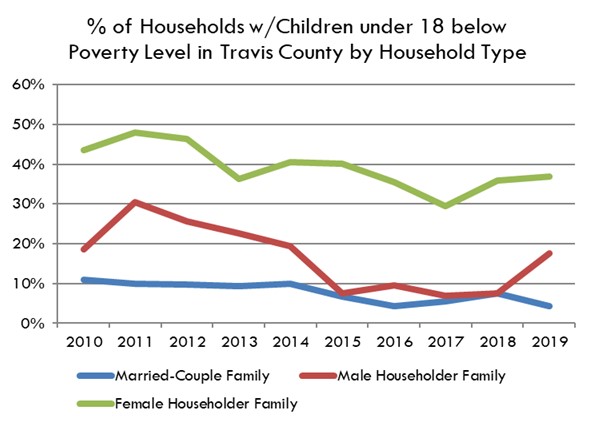
Definition: Percent of the under 18 population living in families with incomes below 100% of federal poverty thresholds, by county, by household type. Federal Poverty Thresholds, as calculated by the U.S. Census Bureau can be accessed here.
Data Source: American Community Survey, 1-year Estimates
Data Considerations: The American Community Survey samples 3% of the Nation’s population. Due to small sample sizes, margins of error are increased and hard to reach populations may not be accurately represented in the data.
Languages Spoken
Approximately two-thirds of children in Travis County, 66%, speak English only at home. Nearly all of the remaining third, 28%, speak Spanish at home. About 3% speak Asian & Pacific Islander languages at home, or other Indo-European languages.
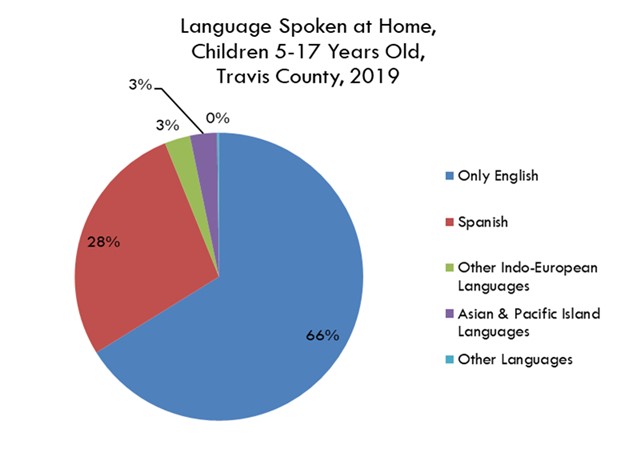
Definition: Share of children, ages 5 to 17, who primarily speak each language type at home. A breakdown of the languages included in each grouping is available at: www.census.gov/hhes/socdemo/language/
about/index.html
Data Source: American Community Survey, 1-year Estimates
Data Considerations: The American Community Survey samples 3% of the Nation’s population. Due to small sample sizes, margins of error are increased and hard to reach populations may not be accurately represented in the data. The American Community Survey question asks respondents to provide the language they speak at home. Children may be fluent in another language that is not the language predominantly spoken at home.
